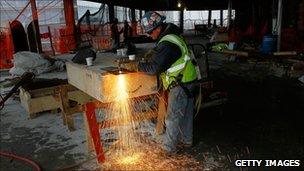Australia faces wage inflation as mining fuels growth
- Published
_rdax.jpg)
The boom in Australia's mining has seen a rise in the employment in the sector
To visit Perth airport early on a Monday morning is to witness the gold-rush style boom times of the Australian economy.
Long before dawn, the departure lounges of private plane charter companies are packed with mine workers.
Dressed in fluorescent safety jackets, they have the names of the big resources giants such as BHP Billiton and Rio Tinto emblazoned on their sleeves.
Sat shoulder to shoulder - or burly, tattooed forearm to burly, tattooed forearm - these are the fly-in fly-outs who commute each week from the state capital to the mining fields of the Pilbara and elsewhere where they can earn enviably large blue collar wages.
Booming salaries
Full-time earnings in Australia average 66,594 Australian dollars ($69,000; £42,500).
In mining, the average wage is $A108,009, making it by far the highest paid sector.
In financial services and insurance, the next most lucrative sector, the average is just over $A80,000.
Perth itself now has the look of an Australian Dallas, its skyline dotted with skyscrapers that have risen as landmarks to its prosperity.
Indeed, the makers of the recently released film Oranges and Sunshine, which is supposed to be set in the Western Australia capital in the 1980s, had to film its outdoor scenes in Adelaide because Perth looked too modern and shiny.
As for the mining fields, they are remote and often harsh environments, where summer temperatures can soar above 46 degrees Celsius. Yet the hardships of working there are considered a small price to pay for the remuneration now on offer.
In this resource-centric, China-linked economy, a truck driver working in the mining sector can enjoy the same earning power as a surgeon, while a lowly rigger can easily take home a more swollen pay packet than a bank manager.
Bloomberg recently cited the example of a 24 year old rigger earning a hefty $A220,000 a year, which is more than Ben Bernanke, the chairman of the Federal Reserve in Washington.
From giant holes in the ground, great personal fortunes are being made. Where there are minerals there is brass.
Wage inflation
In this era of global austerity, it means that Australia is facing the kind of problem that most advanced economies would quite happily endure: wage inflation.
With Australia enjoying something nearing full employment - the jobless rate is fairly steady at just over 5% - and having successfully avoided recession after the global financial crisis, it is confronting the hangover effect of skills shortages, rising wages, and the wider inflationary pressures that accompany them.
It is increasing the likelihood of a hike in interest rates from Reserve Bank of Australia over the next quarter, which has kept the cost of borrowing on hold since last November.
"It's not yet reached the point of an extreme concern, but it's something that the Reserve Bank is definitely keeping an eye on," notes Dr Shane Oliver, the chief economist at AMP Capital Investors.
"It's more of a concern from an inflationary viewpoint rather than the distorting effect it is having on the economy as a whole.
"A truck driver for Woolworths might want to go and work in the mines where he can earn more money, but it has not yet overflowed into the broader economy."
This summer's Queensland and Victoria floods have exacerbated the problem of wage inflation.
Damage to some 30,000 homes has created such a manpower demand for trades people that skills shortages, that great bugbear of the Australian economy, are fuelling wage demands.
Labour shortages

Australia is facing a shortage of skilled labour in many sectors
Prior to the Queensland floods, the Sunshine state was already experiencing labour shortages, partly because of the expansion of the minerals sector and the major infrastructure improvements necessary for its growth.
Australia's still powerful union movement is also looking to cash in.
Emboldened by the jobless figures that show near full employment and citing cost of living pressures, they are demanding hefty wage increases for their workers.
The Construction, Forestry, Mining and Energy Union, which has more than 140,000 members, has been seeking pay increases of almost 25% over four years.
Confronted by labour shortages, the federal government has recently announced the fast-tracking of visas for skilled immigrants and launched an adult apprenticeship programme aimed at retooling existing workers.
With the resources sector alone expected to be some 36,000 workers short over the next four years, it has also been trying to lure older workers back into the jobs market and to persuade part-time employees to work longer hours.
So Australia finds itself confronting a paradox at once peculiar and rare: one of the central threats to its continued prosperity is its continued prosperity, and the wage demands that have come with it.